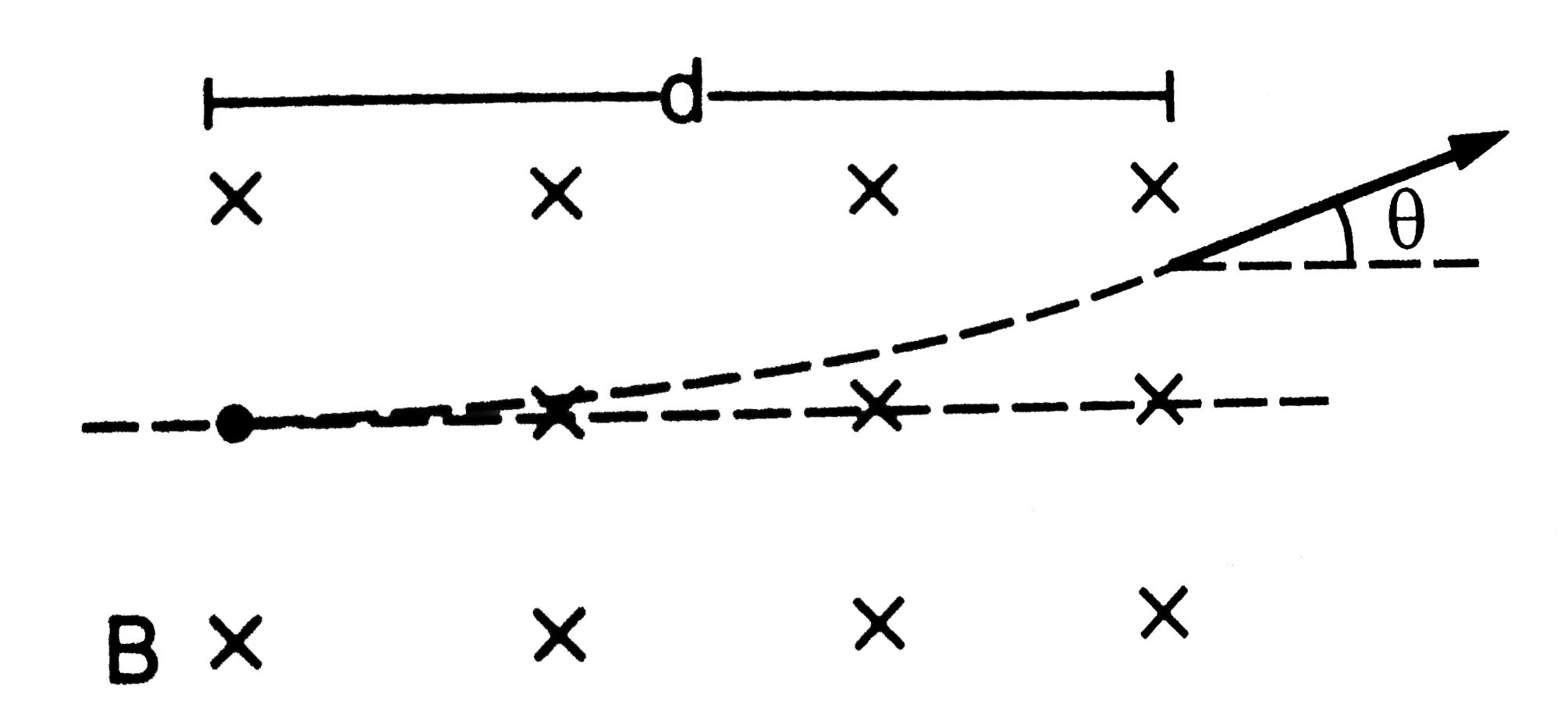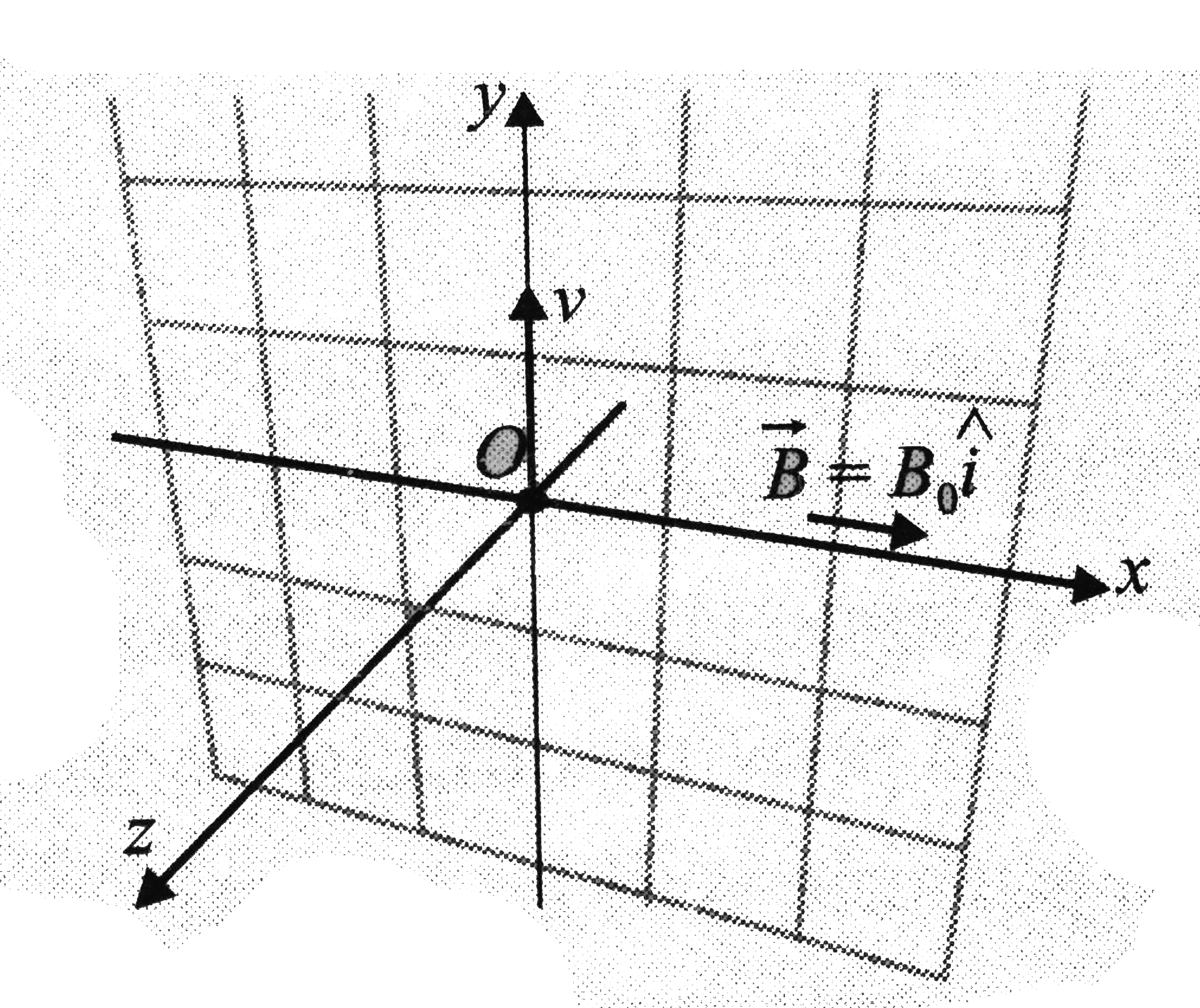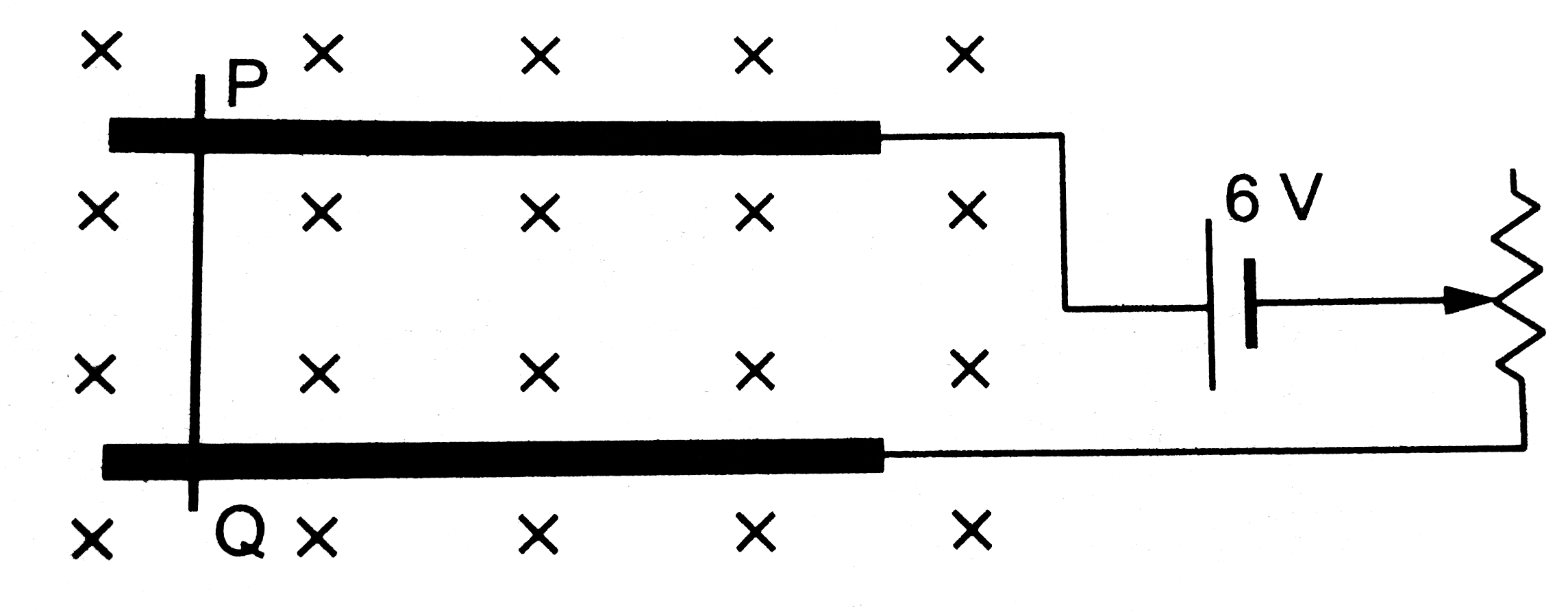Complete Solutions to Illustration of chapter MAGNETIC FIELD AND MAGNETIC FORCES of Class 12 book with complete answers and questions
| Class 12 | PHYSICS |
| Chapter | MAGNETIC FIELD AND MAGNETIC FORCES |
| CENGAGE PHYSICS | Illustration |
| Number Of Questions | 36 |
| Academic Year | 2023-24 |
A particle having mass m and charge q is released from the origin in a region in which electric field and magnetic field are given by
` vecB =- B_0vecJ and vecE = E_0 vecK.`
Find the speed of the particle as a function of its z-coordinate.
View SolutionA charge `q=-4 mu C` has an instantaneous velocity`vec v = (2 hat i - 3 hat j + hat k)xx10^6 ms^-1` in a uniform magnetic field `vec B = (2 hat i + 5 hat j - 3hat k)xx10^-2 T.` What is the force on the charge?
View SolutionDoubly ionized helium ions are projected with a speed of `10kms^(-1)` in a direction perpendicular to a uniformmagnetic field of magnitude 1.0 T. Find (a) the force acting on an ion, (b) the radius of the circle in which it ciruclates and ( c) the time taken by an ion to complete the circle.
View SolutionA stream of protons and deuterons in a vacuum chamber enters a uniform magnetic field. Both protons and deuterons have been subjected to same accelerating potential, hence the kinetic energies of the particles are the same. If the ion-stream is perpendicular to the magnetic field and the protons move in a circular path of radius 15 cm, find the radius of the path traversed by the deuterons. Given that mass of deuteron is twice that of a proton.
View SolutionA particle of mass m and charge q is projected into a region having a perpendicular magnetic field B. Find the angle of deviation fo the particle as it comes out of the magnetic field if the width d of the regions is very smaller then

View SolutionAn `alpha-`particle is accelerated by a potential difference of `10^4 V.` Find the change in its direction of motion, if it enters normally in a region of thickness 0.1 m having transverse magnetic induction of 0.1 tesla. (Given: mass of `alpha-`particle `6.4xx10^(-27)`kg).
View SolutionA charged particle of mass m and charge q is accelerated through a potential difference of V volts. It enters a region of uniform magnetic field which is directed perpendicular to the direction of motion of the particle. Find the radius of circular path moved by the particle in magnetic field.
View SolutionA beam of charged particle, having kinetic energy `10^3 eV`, contains masses `8xx10^(-27) kg and 1.6xx10^(-26) kg` emerge from the end of an accelerator tube. There is a plate at distance `10^2 m` from the end of the tube and placed perpendicular to the beam. Calculate the magnitude of the smallest magnetic field which can prevent the beam from striking the plate.
View SolutionA proton (charge `1.6xx10^(-19) C, mass = 1.67xx10^(-27) kg)` is shot with a speed `8xx10^6 ms^-1` at an angle of `30^@` with the X-axis. A uniform magnetic field `B=0.30 T` exists along the X-axis. Show that path of the proton is a helix. Find the radius and pitch of the helix.
View SolutionAn electron accelerated by a potential difference `V=1.0 kV` moves in a uniform magnetic field at an angle `alpha = 30^@` to the vector B whose modulus is `B=29 mT.` Find the pitch of the helical trajectory of the electron.
View SolutionThe magnetic field is confirmed in a square region. A positive charged particle of charge q and mass m the limiting velocities of the particles so that it may come out of face (1), (2), (3), and (4).

View SolutionA charge particle of mass m and charge q is projected with velocity v along y-axis at `t=0.`

Find the velocity vector and position vector of the particle `vec v (t) and vec r (t)` in relation with time.
View SolutionIf in previous illustration, The charge particle is projected at angle `alpha` with x-axis with magnitude of velocity. Find
a. velocity vector in function of time `vec v (t).`
b. position vector in function of time `vec r (t).`

View SolutionAn electron accelerated by a potential difference 2.5 kV moves horizontally into a region of space in which there is a downward directed uniform electric field of magnitude `10 kVm^-1.`
(a) In what direction must a magnetic field be applied so that the electron moves undeflected? Ignore the gravitational force. What is the magnitude of the smallest magnetic field possible in this case?
(b) What happens if the charge is a proton that passes through the same combination of fields ?
View SolutionA proton beam passes without deviation through a region of space, where there are uniform tranverse mutully perpendicular electric and magnetic field with E = 220 kV/m and B = 50 mT.Then the beam strikes a grounded target.Find the force imparted by the beam on the target, if beam current is equal to i = 0.80 mA
View SolutionA mass spectrometer separates ions according to their ratio of charge to mass. Such devices are widely used in silence and engineering to analyze unknown mixtures and to separate isotopes of chemical elements. Figure 1.24 shows ions of charge q and mass m first being accelerated from rest through a potential difference V and then entering a region of uniform magnetic field B pointing out of the page. Only the magnetic force acts on the ions in this region, so they undergo circular motion and, after half an orbit, land on a detector. Find an expression for the horizontal distancexxfrom the entrance slit to the point where an ion lands on the detector.

View SolutionA wire of length l carries a current I along the x-asis. A magnetic field exists which is given as `vecB=B_0(veci+vecj+veck)` T. find the magnitude of the magnetic force acting on the wire.
View SolutionA matel wire PQ of mass 10g lies at rest on two horizontal metal rails separated by 4.90 cm . A vertically downward magnetic field of magnitude 0.800 T exists in the space. The resistance of the circuit is slowly decreased and it is found that when the resistance goes below`20.0 Omega`, the wire PQ starts sliding on the rails. Find the coefficient of friction.

View SolutionShows a rod PQ of length 20.0 cm and mass 200g suspended through a fixed point O by two threads of lengths 20.0 cm each. A magnetic field of strenght 0.500 T exists in the vicinity of the wire PQ as shown in the figure. The exists in the vicinity of the wire PQ as shown in the figure. The wires conecting PQ with the battery are loose and exert no force on PQ.(a) find the tension in the threads when the switch S is open. (b) A current of 2.0 A is established when the switch S is closed. Find the tension in the threads now.

View SolutionThe magnetic field existing in a region is given by
`B=B_(0)[1+(x)/(l)]hat(k)`
A square loop of edge l and carrying current I is placed with its edges parallel to the X and Y-axes. The magnitude of the net magnetic force experienced by the loop is
View SolutionIn the figure shown a semicircular wire loop is placed in a uniform magnetic field B = 0.1 T.The plane loop in a uniform magnetic field Current I = 2 A flows in the loop in the direction force in both the (a) amd (b) . The redius of the loop 1.0 m

View SolutionA circular loop of radius a, carrying a current I, is placed in a tow dimensional magnetic field. The centre of the loop coincides with the centre of the filed The strenght of the magnetic field at the pariphery of the loop is B. find the magnetic force on the wire.

View SolutionA hypthetical magnetic field existing in a region is given by `vecB= B_0 vece_r,` where `vec_r` denotes the uit vector along the redial direction. A circular loop of radus a, carrying a current I, is placed with its plane parallel to the x-y plane and the centre at (0,0, d) .Find the magnitude of the magnetic force acting on the loop.
View SolutionA conducting wire of length `l` is placed on a rough horizontal surface, where a uniform horizontal magnetic field B perpendicular to the length of the wire exists. Least values of the forces required to move the rod when a current `I` is established in the rod are observed to be `F_1` and `F_2 (lt F_1)` for the two possible directions of the current through the rod, respectively. Find the weight of the rod and the coefficient of friction between the rod and the surface.
View SolutionA conductor (rod) of mass m, length `l` carrying a current i is subjected to a magnetic field of induction B. If the coefficients of friction between the conducting rod and rail is `mu,` find the value of I if the rod starts sliding.

View SolutionA wire of 60 cm length and mass 16 gm is suspended by a pair of flexible leads in a magnetic field of induction 0.40 T. What are the magnitude and direction of the current required to remove the tension in the supporting leads?

View SolutionCompute the magnetic dipole moment of the loop shown in Fig. 1.69

View SolutionA circular loop of wire of radius R is bent about its diameter along two mutually perpendicular planes as shown in Fig. If the loop carries a current I, then determine its magnetic moment.
View SolutionA conductor carries a constant current I along the closed path abcdefgha involving 8 of the 12 edges of length `l`. Find the magnetic dipole moment of the closed path.
View SolutionConsider a nonconducting plate of radius r and mass m which has a charge q distributed uniformly over it. The ring is rotated about its axis with an angular speed `omega` Show that the magnetic moment `mu` and the angular momentum I of the plate are rlated as `mu = (q)/(2m)l.`
View SolutionA coil in the shape of an equilateral triangle of side 0.02 m is suspended from a vertex such that it is hanging in a vertical plane between the pole pieces of a permanent magnet producing a horizontal magnetic field of `5 xx 10^(-2) T.` Find the couple acting on the coil when a current of 0.1 A is passed through it and the magnetic field is parallel to its plane.
View SolutionA circular coil of wire 8 cm in diameter has 12 turns and carries a current of 5 A. The coil is in a field where the magnetic induction is 0.6 T.
a. What is the maximum torque on the coil?
b. In what position would the torque be half as great as in (i) ?
View SolutionA wire is wrapped N times over a solid sphere of mass m which is place on a smooth horizontal surface. A horizontal magnetic field of induction `vec B` is present. Find the (a) torque (b) angular acceleration experienced by the sphere. Assume that the mass of the wire is negligible compared to the mass of the sphere.

View SolutionA galvanometer having 30 divisions has current sensitivity of `20 mu A//"division"`. Find the maximum current it can measure.
View SolutionA rectangular coil of area `5.0xx10^(-4) m^2` and 60 turns is pivoted about one of its vertical sides. The coil is in a radial horizontal field of 90 G (radial here means the field liners are in the plane of the coil for any rotation). What is the torsional constant of the hair spring connected to the coil if a current of 2.0 mA produces an angular deflection of `18^@`?
View SolutionThe coil of a galvanometer is `0.02xx0.8 m^2`. It consists of 200 turns of the wire and is in a magnetic field of 0.20 T. The restoring torque constant of suspension fibre is `10^(-5) Nm//degree.` Assuming magnetic field to be radial
(a) What is the maximum current that can be measured by this galvanometer if scale can accommodate `45^@` deflection?
(b) What is the smallest current that can be detected if minimum observed deflection is `0.1^@`?
View Solution
Illustration questions and complete solutions for chapter MAGNETIC FIELD AND MAGNETIC FORCES of CENGAGE PHYSICS (ENGLISH) of Class 12
All Exercises from CENGAGE PHYSICS Class 12 PHYSICS MAGNETIC FIELD AND MAGNETIC FORCES
- Archives Assertion-reasion
- Archives Comprehension
- Archives Fill In The Blank
- Archives Integer
- Archives Multiple Correct
- Archives Single Correct
- Archives True /false
- Comphension Based
- Comprehension type
- Exercise 1.1
- Exercise 1.2
- Exercise1.3
- Exercises Assertion -reasoning
- Exercises Integer
- Exercises Linked Comprehension
- Exercises Multiple Correct
- Exercises Single Correct
- Exercises Subjective
- Illustration
- Multiple
- Multiple Correct Answer type
- Single Correct Answer Type
- Solved Example
- Subjective
- Subjective type